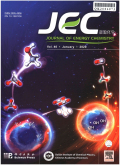- 钛学术文献服务平台 \
- 学术期刊 \
- 工业技术期刊 \
- 石油与天然气工业期刊 \
- 能源化学期刊 \
Advances in high carbon dioxide separation performance of poly(ethylene oxide)-based membranes
Advances in high carbon dioxide separation performance of poly(ethylene oxide)-based membranes
基本信息来源于合作网站,原文需代理用户跳转至来源网站获取
摘要:
Poly (ethylene-oxide) (PEO)-based membranes have attracted much attention recently for CO2 separation because CO2 is highly soluble into PEO and shows high selectivity over other gases such as CH4 and N2. Unfortunately, those membranes are not strong enough mechanically and highly crystalline, which hin-ders their broader applications for separation membranes. In this review discussions are made, as much in detail as possible, on the strategies to improve gas separation performance of PEO-based membranes. Some of techniques such as synthesis of graft copolymers that contain PEO, cross-linking of polymers and blending with long chains polymers contributed significantly to improvement of membrane. Incor-poration of ionic liquids/nanoparticles has also been found effective. However, surface modification of nanoparticles has been done chemically or physically to enhance their compatibility with polymer ma-trix. As a result of all such efforts, an excellent performance, i.e., CO2 permeability up to 200 Barrer, CO2/N2 selectivity up to 200 and CO2/CH4 selectivity up to 70, could be achieved. Another method is to introduce functional groups into PEO-based polymers which boosted CO2 permeability up to 200 Barrer with CO2/CH4 selectivity between 40 and 50. The CO2 permeability of PEO-based membranes increases, without much change in selectivity, when the length of ethylene oxide is increased.

推荐文章
Carbon dioxide emissions from the Three Gorges Reservoir, China
CO2 emissions
Three Gorges Reservoir
River-type reservoir
Rapid and sensitive method for determining free amino acids in plant tissue by high-performance liqu
HPLC
OPA
FMOC
Free amino acids
Plant
PLS-DA
Forest carbon storage in Guizhou Province based on field measurement dataset
Forest carbon storage
Field measurement dataset
Karst landform
内容分析
关键词云
关键词热度
相关文献总数
(/次)
(/年)
引文网络
引文网络
二级参考文献 (0)
共引文献 (0)
参考文献 (0)
节点文献
引证文献 (0)
同被引文献 (0)
二级引证文献 (0)
2020(0)
- 参考文献(0)
- 二级参考文献(0)
- 引证文献(0)
- 二级引证文献(0)
引文网络交叉学科
相关学者/机构
期刊影响力
能源化学
主办单位:
中国科学院大连化学物理研究所
中国科学院成都有机化学研究所
出版周期:
双月刊
ISSN:
2095-4956
CN:
10-1287/O6
开本:
出版地:
大连市中山路457号
邮发代号:
创刊时间:
语种:
eng
出版文献量(篇)
2804
总下载数(次)
0
总被引数(次)
7996
期刊文献
相关文献
推荐文献
- 期刊分类
- 期刊(年)
- 期刊(期)
- 期刊推荐
一般工业技术
交通运输
军事科技
冶金工业
动力工程
化学工业
原子能技术
大学学报
建筑科学
无线电电子学与电信技术
机械与仪表工业
水利工程
环境科学与安全科学
电工技术
石油与天然气工业
矿业工程
自动化技术与计算机技术
航空航天
轻工业与手工业
金属学与金属工艺
能源化学2022
能源化学2021
能源化学2020
能源化学2019
能源化学2018
能源化学2017
能源化学2016
能源化学2015
能源化学2014
能源化学2013
能源化学2012
能源化学2011
能源化学2010
能源化学2009
能源化学2008
能源化学2007
能源化学2006
能源化学2005
能源化学2004
能源化学2003
能源化学2002
能源化学2001
能源化学2020年第9期
能源化学2020年第8期
能源化学2020年第7期
能源化学2020年第6期
能源化学2020年第5期
能源化学2020年第4期
能源化学2020年第3期
能源化学2020年第12期
能源化学2020年第11期
能源化学2020年第10期
能源化学2020年第1期

 免费查重
免费查重










